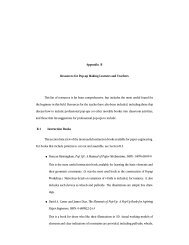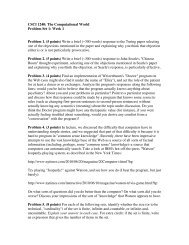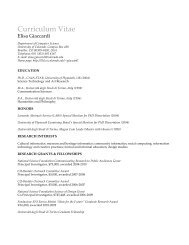A Conceptual Framework for Computer- Supported Collaborative ...
A Conceptual Framework for Computer- Supported Collaborative ...
A Conceptual Framework for Computer- Supported Collaborative ...
You also want an ePaper? Increase the reach of your titles
YUMPU automatically turns print PDFs into web optimized ePapers that Google loves.
� meta-design: the EDC was envisioned to be a end-user modifiable version of<br />
Simcity, allowing participants (1) to contextualize the existing environment<br />
to their own situation, (2) to integrate different in<strong>for</strong>mation sources, and (3)<br />
to develop new structures and processes;<br />
� cultures of participation: the EDC is an environment that is not restricted to<br />
the delivery of predigested in<strong>for</strong>mation to individuals, but it provides<br />
opportunities and resources <strong>for</strong> design activities embedded in social debates<br />
and discussions in which all stakeholders can actively contribute rather than<br />
being confined to passive consumer roles;<br />
� social creativity: the EDC supports emerging insight as illustrated by the<br />
example in Figure 5 in which participants collaboratively try to decide the<br />
best location of a bus stop by analyzing multiple walking distances.<br />
Participants indicate where they live on the map (resulting in a house icon<br />
appearing at that location). They are supported with task-focused interaction<br />
mechanisms to indicate how far they would be willing to walk in good and<br />
bad weather. After specifying this in<strong>for</strong>mation, colored circles (generated by<br />
the system) appear around their individual house icons, indicating the range<br />
of area that they might be willing to walk to catch a bus. The display<br />
(bringing together the results of their individual decisions) shows emerging<br />
patterns of areas that are suitable <strong>for</strong> bus routes and bus stops, providing<br />
in<strong>for</strong>mation and perspectives that no individual had in her or his head prior<br />
to the problem solving session. The externalization created by individual<br />
actions serves as a source of social creativity <strong>for</strong> further design and decision<br />
making.<br />
Figure 5: Emerging <strong>Collaborative</strong> Insights based on Individual Contributions in a Walking-<br />
Distance Scenario<br />
Gerhard Fischer 14 Contribution to Book “CSCL at Work”















